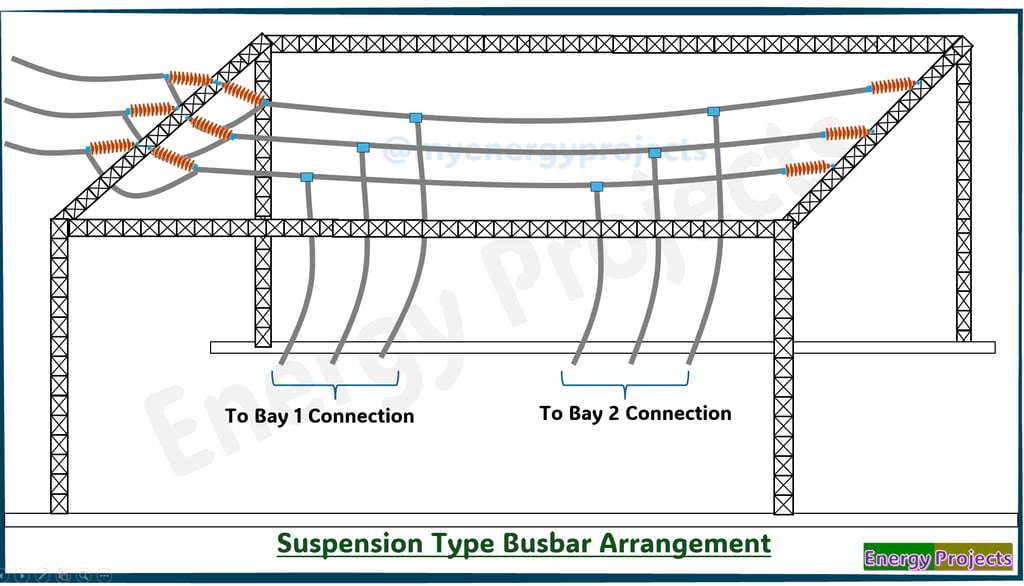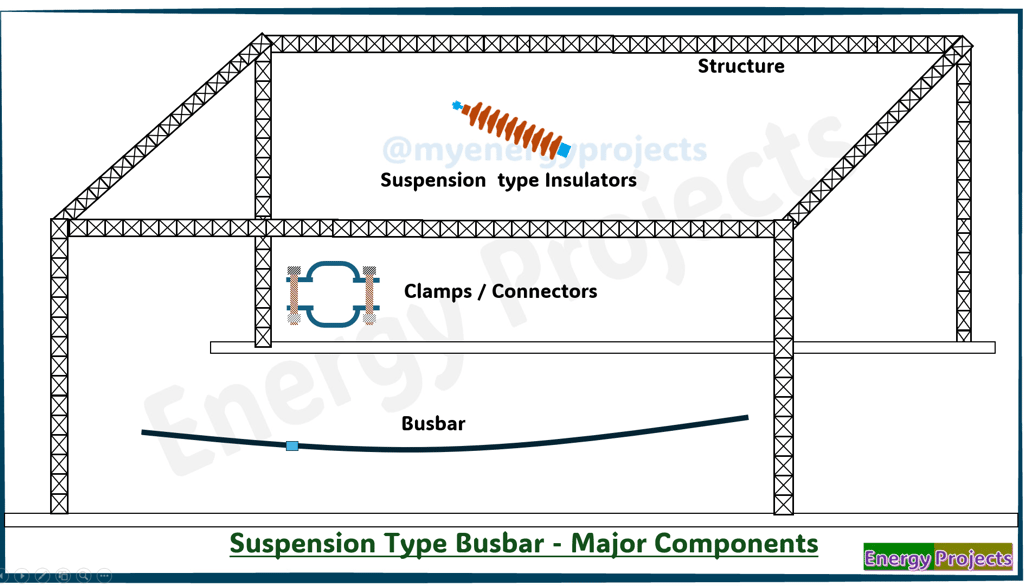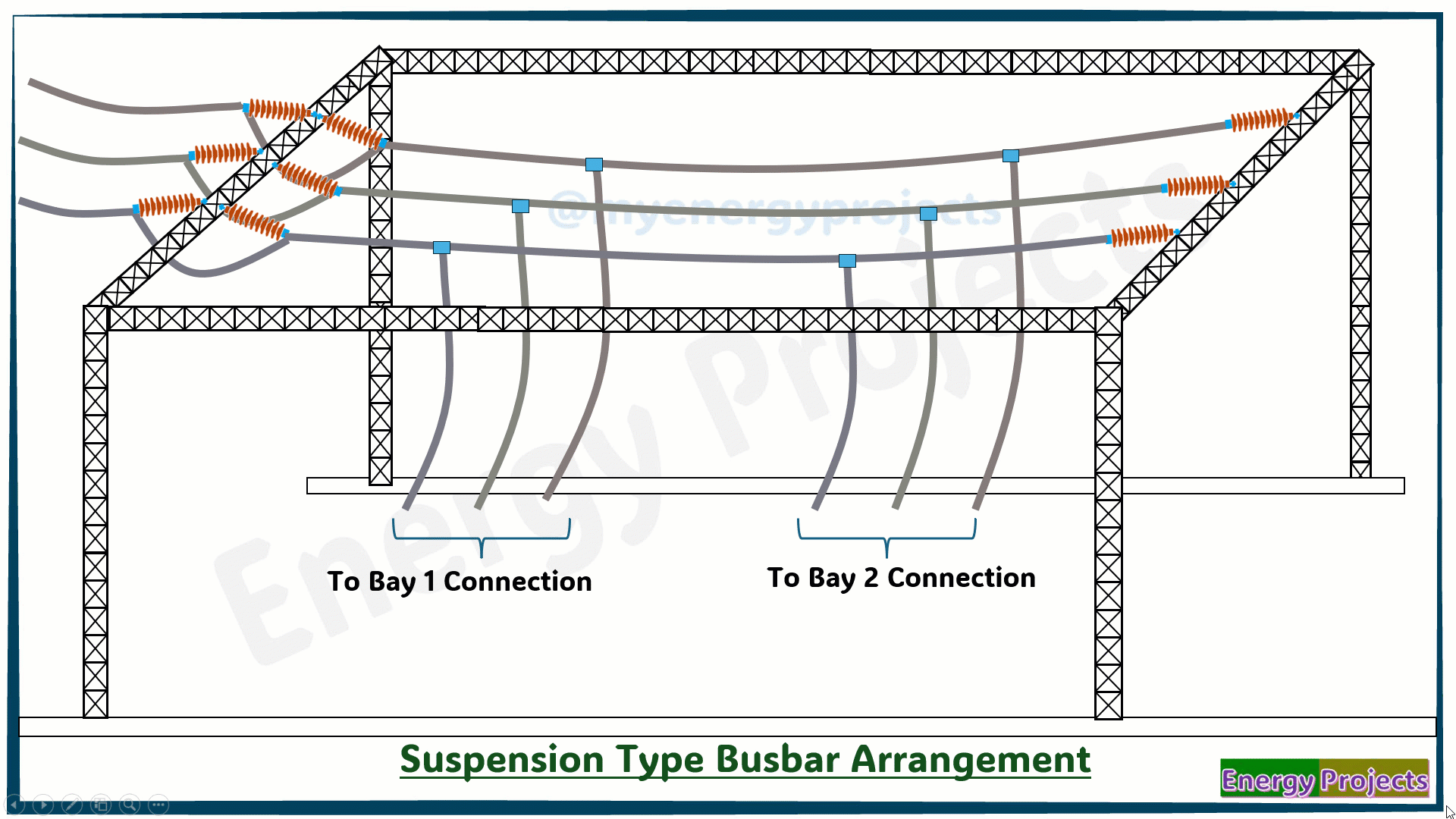02.Suspension Type Busbar Conductor
Arrangement


Single Busbar Configuration
Single Busbar with Bus section Configuration
Single Busbar with Transfer busbar configuration
Single Busbar with Bus section + Transfer bus coupler + Section Isolator configuration
Double Busbar with Bus coupler Configuration
Double Busbar with Bus coupler + Bypass Isolator Configuration
Double Busbar with Bus coupler + Transfer Buscoupler configuration
One and Half Breaker Busbar Configuration
Busbar Configuration
Track Sequence of Engineering
A suspension type busbar conductor arrangement is a method of supporting high-voltage busbars by hanging them from insulators rather than mounting them rigidly on top of post insulators. This setup is commonly used in outdoor AIS (Air-Insulated Substations). its Two types
Advantages of Suspension Type Busbars:
Flexible Installation – Suitable for long spans and adaptable layouts due to the use of flexible conductors.
Cost-Effective – Uses standard overhead conductors and lighter steel structures, reducing material and installation costs.
Lightweight Design – Less structural load compared to rigid busbars, ideal for large outdoor substations.
Simple Expansion – Easier to modify or extend the busbar system as future loads grow.
Handles Movement Well – Better suited for environments with thermal expansion or minor structural shifts.
Disadvantages of Suspension Type Busbars:
Less Mechanical Stability – Flexible conductors offer less structural strength compared to rigid bars.
More Sag and Clearance Management – Requires precise design to control conductor sag and maintain electrical clearances.
More Maintenance-Prone – Conductor tension and insulator condition need regular inspection.
Exposed to Environment – Wind, temperature changes, and weathering can affect performance.
Layout Is Less Compact – Requires larger space due to sag, swing, and wider phase separation in outdoor setups.


Rigid busbar - Major Components
Busbar
Clamps / Connectors
Structure
Suspension type Insulator
Busbar:
A suspension type busbar is a flexible conductor, typically made of stranded aluminum or ACSR (Aluminum Conductor Steel Reinforced), used for high-voltage power distribution in outdoor substations. It is supported by suspension insulators hung from steel structures, allowing the conductor to sag naturally while maintaining electrical isolation and mechanical stability.
Clamps / Connectors:
Clamps and connectors in suspension type busbar arrangements ensure secure electrical and mechanical connections between flexible conductors and equipment terminals. Typically made from aluminum or copper, they may be tin- or silver-plated to minimize contact resistance and corrosion. Common types include compression connectors, tension clamps, and suspension clamps designed to hold the conductor under tension. These components are built to withstand high currents, mechanical loads, and environmental exposure in outdoor high-voltage installations.
Structure:
Steel structures used to hold suspension insulators in high-voltage substations provide mechanical support for flexible busbars and associated conductors. These structures are typically made of galvanized steel to resist corrosion and are designed to withstand wind, conductor tension, and seismic forces. Common types include gantries, portal frames, and dead-end towers. They are engineered to maintain proper electrical clearances and securely support suspension insulators, ensuring safe and stable operation of the overhead busbar system.
Suspension type Insulator
Suspension insulators are used to support and electrically isolate flexible busbars or conductors in high-voltage substations with suspension-type arrangements. They are typically hung from steel gantries or portal structures and hold the conductor below, allowing it to sag naturally while remaining electrically insulated from the support structure. Made from porcelain or polymer, suspension insulators are designed to withstand high mechanical tension, electrical stress, and environmental conditions. They help maintain safe clearances and ensure reliable performance of the suspended busbar system.
Operation:
You can see the operation of Suspension type busbar arrangement.


